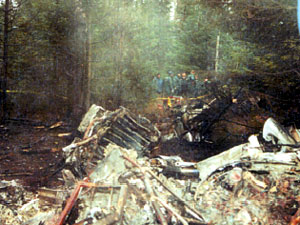| Remembering Wellstone |
|
Audio
Photos
More from MPR
Resources
Your Voice
|
NTSB blames pilots for crash that killed Wellstone, 7 others
November 18, 2003
 |
| The site of the Wellstone plane crash. (National Transportation Safety Board) |
Washington, D.C. — Investigators today laid the blame for the plane crash that killed Senator Paul Wellstone and seven others in October 2002 squarely in the laps of the pilots.
They told a hearing of the National Transportation Safety Board in Washington that the plane crashed because the pilots waited too long to lower the plane's landing gear, then slowed to a speed that would allow the gear to be lowered safely. When the gear was lowered, the airspeed quickly disintegrated and the plane stalled, then crashed in a swamp a quarter-mile from the runway, killing everyone aboard.
|
We believe the airplane slowed... not because of icing, but because the flight crew did not monitor and maintain a minimum airspeed at the end of the approach. This can happen through inattention, distraction, and by not adhering to standard operating procedures, cockpit resource management techniques, and training.
- Kurt Perrara, NTSB investigator |
Investigators suggested the flight crew was preoccupied with getting the plane on a proper approach to the airport. Chief investigator Frank Hilldrup says pilot Richard Conroy overshot the approach ten miles away from the runway. Conry first was too far north, then turned and ended up too far south.
"The flight crew should've been able to recover from the overshoot," said Hilldrup.
"We believe the airplane slowed to near the expected stall speed near the end of the radar data, not because of icing, but because the flight crew did not monitor and maintain a minimum airspeed at the end of the approach. This can happen through inattention, distraction, and by not adhering to standard operating procedures, cockpit resource management techniques, and training," said Charlie Pereira, NTSB Aircraft Performance Group chairman.
He said the pilots ignored their own company's guidelines which called for the the pilots to break off their approach if they were off-course within two miles of the runway.
SHOULD'VE GONE AROUND, INVESTIGATORS SAY
Hilldrup criticized the company for not properly training the pilots for "go-around" operating procedures, but saved his most severe criticism for the pilots themselves. "It is apparent the flight crew was not fully aware of the ... requirements necessary to make a stabilized approach," he said.
NTSB chairwoman Ellen Engleman said the poor approach initiated a series of mistakes. "We found in almost all of our accidents, it's never one single moment, but it's always a criticality of a variety of factors that build up," she said. "There becomes almost a domino effect; when you have an accident such as this you can certainly see it. There were several opportunities for them to change course, to be aware of their airspeed. At each time there was something that caused them to fail to do so. Ultimately this accident was the result of a sequence of events and, tragically, all the lives were lost because of that."
On the day of the crash Wellstone and his entourage were traveling to Eveleth to attend the funeral of the father of long-time friend Rep. Tom Rukavina, DFL-Virginia. Later, Wellstone was to take part in a campaign debate with his challenger, former St. Paul mayor Norm Coleman. Killed along with Wellstone were his wife, Sheila, his daughter, Marcia, Will McLaughlin, a campaign staff member, Tom Lapic, campaign staff member, Mary McEvoy, campaign staff member and pilots Richard Conry, captain, and Michael Guess, co-pilot.
 | |||
The accident occurred less than two weeks before election day. Following Wellstone's death, former Vice President Walter Mondale accepted the Democratic candidacy. After a brief campaign, Republican Norm Coleman won the seat Wellstone had held for nearly 12 years.
Investigators said icing played no part in the accident. There had been a strong suspicion that a buildup of ice prevented the pilots from maintaining the necessary airspeed or altitude as it approached the airport. But the investigators' report said the plane spent under 3 minutes in icing conditions, and its last four minutes in conditions in which planes would've shed ice. They also said the plane was well equipped with de-icing equipment which would've mitigated any icing problem.
Ice on a plane's wing disrupts the air flow, causing the wing to lose its lift, often causing a plane to spin and crash.
NAVIGATION BEACON NOT AT FAULT
Investigators also played down the apparent inaccuracy of a navigation beacon at the airport in Eveleth.
 | |||
Although a pilot who landed at Eveleth several hours before the ill-fated flight was due to arrive reported that the beacon "worked fine," investigators who duplicated the flight path in an airplane the day after the crash found that while the "beacon" appeared to guide them properly until about four miles from the runway, it then suggested they were too far left, and then too far right as they approached the airport.
But the investigators said the beacon was accurate within two miles of the runway and the fact it was "slightly out of tolerance" as far as 10 miles away should not have prevented the pilots from making a proper approach.
Hilldrup said the pilot first veered off course to the north because he didn't get clearance from an air traffic controller soon enough to make a required turn. But he said he could not say why the pilot, Richard Conry, missed a second turn when he turned to the south. "There was a lot going on at the time," said investigator John Clark, the NTSB's director of aviation safety.
The effect of weather on the day of the crash was minimized by investigators.
On the morning Of October 25, 2002, pilot Richad Conry initially decided he wouldn't make the flight after receiving a weather briefing.
Conry told a specialist at the Princeton Flight Service Station, "You know what? I don't think I'm going to take this flight."
But an hour later -- shortly after 8 a.m. -- he called back to file a flight plan for the flight, even though the clouds at his destination had dropped from about 2,000 feet to about 900 feet.
Before leaving from St. Paul Downtown Airport, a pilot, who had just arrived from Duluth, had spoken to Wellstone about weather conditions. He told Wellstone, in the last days of a close re-election campaign, that "the weather was at minimums, but the pilots could handle it," the report said.
But investigators presented evidence that it was Conry, not the weather, that contributed most to the disaster.
NTSB MAKES FINDINGS AND RECOMMENDATIONS
As a result of the crash, the investigators recommended the NTSB ask the FAA to require better crew training to prevent future accidents. NTSB member Carol Carmody said investigating the accident would've been easier had the air carrier been required to equip the plane with a cockpit voice recorder or cockpit data recorder.
Investigators also suggested that enhanced airspeed alerting systems for pilots could help prevent future accidents. Inattention and distraction can lead pilots to allow aircraft to slow to dangerous airspeeds, they said. They said there have been 18 air crashes since 1980 due to pilots inadvertently losing the airspeed required to keep their planes flying.
They said existing "stall" warnings don't activate until well after the airspeed has slipped to those dangerous levels. In this crash, they said, up to 40 seconds elapsed before the pilots were made aware of the situation, too late to allow them to avoid a stall and crash.
Investigators said when the plane crashed, its wings were level, apparently indicating that pilots were trying to keep the airplane flying, but ran out of time, and altitude.
Wellstone's family the families of five other passengers killed in the crash reached a $25 million insurance settlement with the air charter company that operated the flight.
REACTION FROM WELLSTONE COLLEAGUES
Jeff Blodgett, Wellstone's campaign manager in his three races, said the findings, presented Tuesday in Washington at a meeting of the National Transportation Safety Board, were "extremely disturbing."
"It's now crystal clear the crash didn't have to happen and never should have happened," Blodgett said. "Those two pilots should have never been allowed to fly people in that plane, and I hope the people who allowed those pilots to fly with such precious cargo are held responsible."
Wellstone had been using Aviation Charter for senatorial and campaign work since 1992, Blodgett said. He considered himself comfortable flying with Conry.
"He thought he was safe," Blodgett said. "We were not informed of the shortcomings of his background and his experience."
A reporter seeking comment from Conry's widow, Johanne, was turned away from her Twin Cities home on Tuesday. Errol Kantor, a Minneapolis attorney for Ms. Conry, also refused comment.
An attorney for the estate of co-pilot Michael Guess estate didn't immediately return a call seeking comment.
|
News Headlines
|
Related Subjects
|

